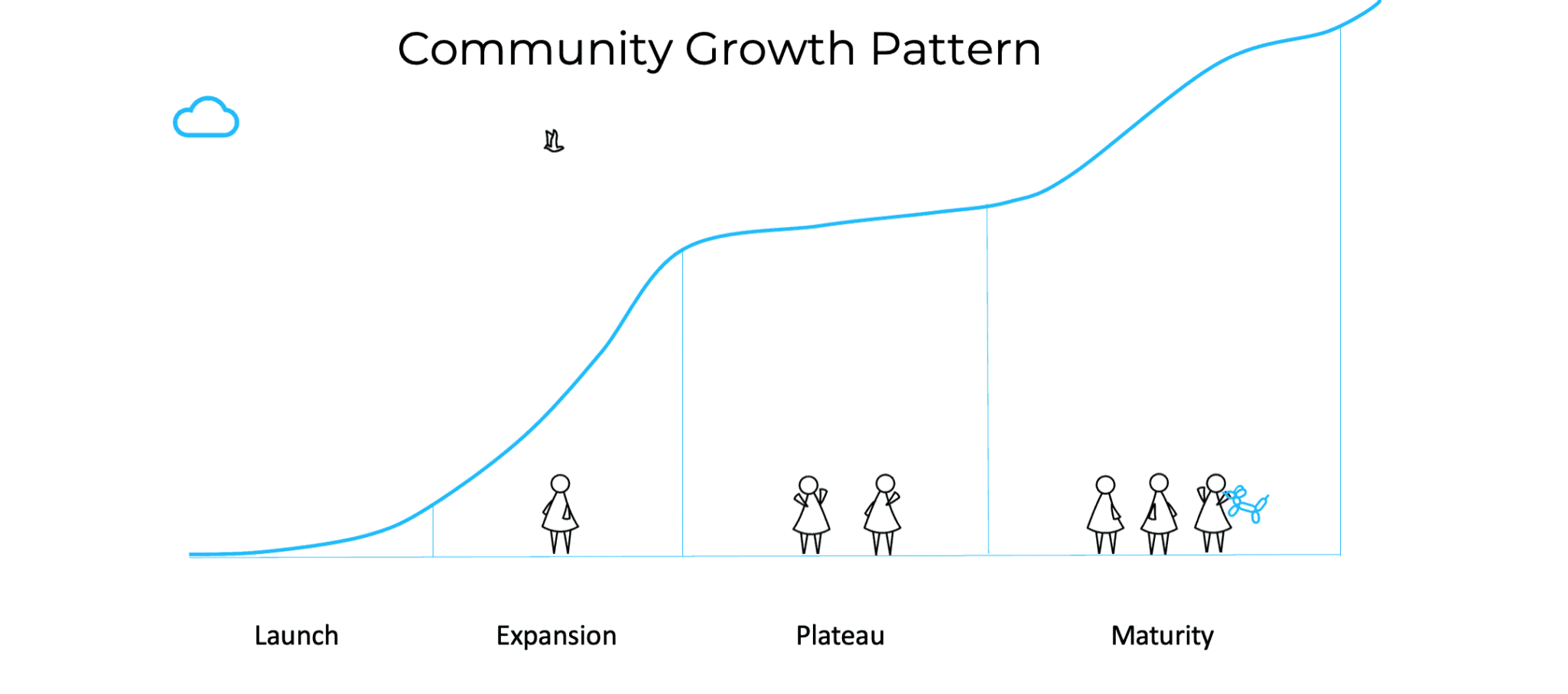Filter by Category
Filter by Category
Contents
An understanding of the growth pattern will enable you to plan and strategize. Not every community grows at the same pace, some will always be slow burns – especially those with limited specialist appeal and few resources. Others expand rapidly achieving tens of thousands of members in the first month. Setting realistic targets and understanding community growth patterns is vital to managing stakeholder expectations. Communities go through four phases; launch, expansion, plateau, and maturity.

Launch
At launch, the community contains almost no members except for the managers and other in-house staff. Invitations should be sent to bring a limited number of selected users in to test the community. The key resource at this point is the quality of the launch contents as there are limited members so few interactions. For brand lead communities it is vital that the key stakeholders for relevant functions are involved at this point and that their buy in is achieved.
Expansion
Once the community starts growing the host needs to generate momentum and focus on achieving its goals. Member acquisition and content generation are the primary focus. Value is created by active contributions from the brand, significant levels of content, and strong brand focus on the exclusivity of belonging. Relationships can be made directly, and informally with individual members who should be encouraged to participate to the maximum.

Plateau
Communities often plateau, hopefully for a short time – a period when they very slowly grow rather than at the speed they had grown before. This period occurs for a number of reasons: a reduced focus on member acquisition, community champions leaving the company, the meeting of initial targets and transition to other projects. It is vital that renewed focus on potential and benefits is used to move through this period. New community projects and growth plans should be put in place. It’s time to take stock of what has been achieved and what could be achieved. It is the point that relationships with members that are particularly important especially the retention of high engagement members/super users.
Maturity
Once past the plateau, a healthy and positive community will grow rapidly. User generated content expands, members adopt new roles, super users contribute more and the sense of belonging increases. ROI increases as the brand and departments receive maximum benefits and feed value into the community. The rich environment and content attract more members growing and scaling the community. At this point the managers role is to engage and continually optimise performance.

Decline (Only if we get it wrong)
A healthy community does not have a finite life, there is no inherent reason for the decline and many like the Apple, Giffgaff, Nike last decades. When there is a decline or closing of a community it is mainly caused by the parent brand failing to understand the value of their customer relationship. Community champions may move on to new organisations and experienced managers leave. This results in a lack of active community management and is often symbolic of bigger long term issues with the company. It’s also worth checking that the current platform aligns with usage trends and migrate if necessary.
Platforms
Choosing a community platform can be intimidating. It’s often easier to opt for social media because of familiarity, but there are many limitations to building a community on a public social media platform. This means that you can end up with a defused unfocused low-engagement community spread across various social media platforms. At Disciple, we often find that treating social media as an advertising platform to feed members to a branded community app or other dedicated community is an effective way to migrate to an existing community. Whether they are forum based (good for answer based customer service communities, community app-based (excellent for monetized and high engagement communities) or integrated within another app (very effective for gaming communities), dedicated communities with a clear focus tend to have more longevity and better community growth.
About the author: Elektra is a member of the marketing team at Disciple. She writes about the latest trends in social media.
Seb Abecasis in
31 May, 2022
3 min read
Share:

See how Disciple can fit your business needs
See how a Disciple community
can fit your business needs
See how a Disciple community can fit your business needs
Related Articles
18 min read
How To Build Your Online Community From Scratch
Wondering how to create a community? How to turn your social media presence into a thriving online community? …
8 min read
How the Best Businesses Build Brand Communities (+Examples)
No matter the name of your brand, the industry you operate in, the products you make or the …
9 min read






